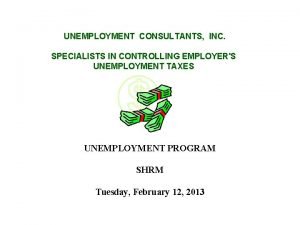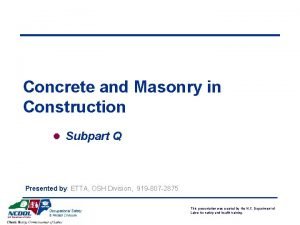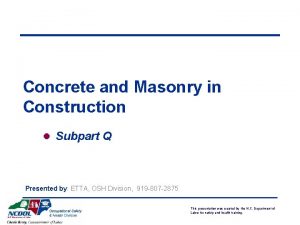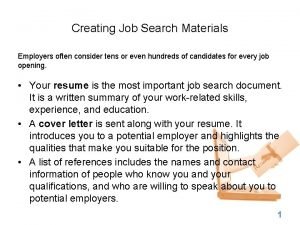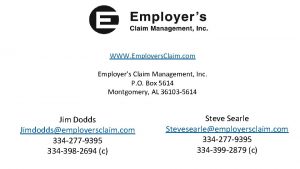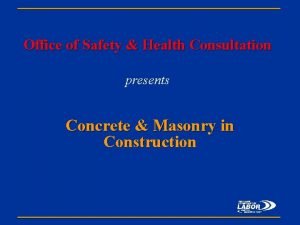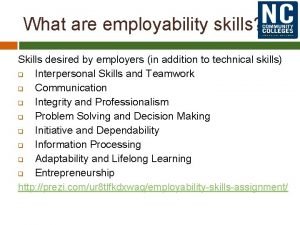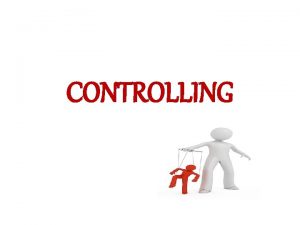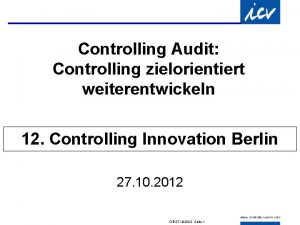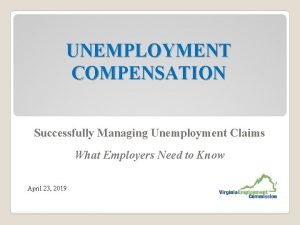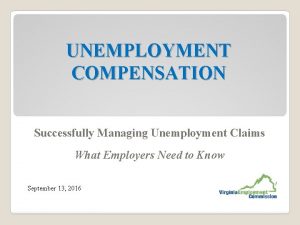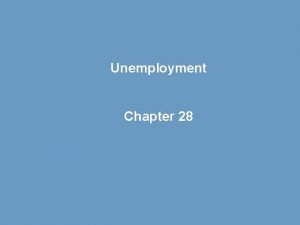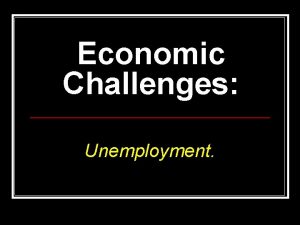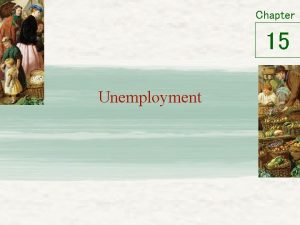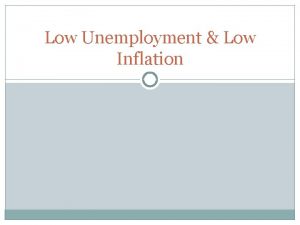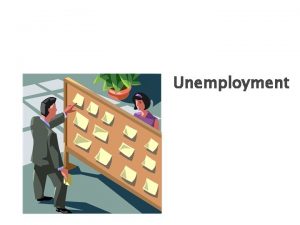UNEMPLOYMENT CONSULTANTS INC SPECIALISTS IN CONTROLLING EMPLOYERS UNEMPLOYMENT























- Slides: 23

UNEMPLOYMENT CONSULTANTS, INC. SPECIALISTS IN CONTROLLING EMPLOYER'S UNEMPLOYMENT TAXES UNEMPLOYMENT PROGRAM SHRM Tuesday, February 12, 2013

AGENDA • Law Changes Effective 1 -1 -13 • Claim Forms Notice of Claim to Chargeable Employer Notice of Claim to Interested Party • Discharge Employees and Deny Benefits • Unemployment Facts

IDES LAW AND RULE CHANGES • On January 1, 2013 monthly wage reports will be required to be filed by each employer with 250 employees in Illinois. • Employers with 100 employees must begin monthly wage reporting July 1, 2013. • Employers with 50 employees must begin filing monthly wage reports January 1, 2014 • Employer with over 25 employees must begin filing monthly wage reports July 1, 2014.

IDES LAW AND RULE CHANGES • The monthly and quarterly wage reports must be filed via taxnet. • IDES will no longer send a UIC/40 to any employer in 2013. • It will be the Employers responsibility to remember to file monthly and quarterly reports.

IDES LAW AND RULE CHANGES • January wage report is due by the last day of February. • February wage report is due by the last day of March • The quarterly report for March is due the last day of April.

IDES LAW AND RULE CHANGES NEW HIRES: • Currently Employers are required to notify IDES of any new hires within 20 days of the employment. • Beginning January 1, 2013 Employers will have to notify IDES of any individual: – who is a new hire. – And any individual RETURNING TO WORK after being off work for 60 calendar days. • Notification can be done via IDES website or fax.

IDES LAW AND RULE CHANGES CLAIM PROTESTS: • Claim protests need to be complete, detailed and all documentation must be submitted with the protest. • IDES is now in process of writing rules as to the consequences if the Employer fails to provide documentation with the initial protest and benefits are allowed.

IDES LAW AND RULE CHANGES Here is the information needed to attach to the protest: • When an Employee is Discharged: letter of termination, details of final incident, prior warnings for the past 6 months, copy of policy violated, signature for the policies, all reports and documents regarding the final incident. • When and Employee has resigned: reason for resignation, letter if provided by the past employee. • Refusal of work: need date of work offer, date work is to begin, job title and duties, rate of pay, locations and hours of the job and reason for the refusal.

IDES LAW AND RULE CHANGES CONSEQUENCES: • We have seen wording that would not allow the Employer to get benefit credit if the information was not provided with the initial claim protest. • For taxing Employers: the credit would not apply to your account and the benefits paid would increase the tax rate assigned each year.

IDES LAW AND RULE CHANGES CONSEQUENCES: • Reimbursing Employers: would not receive the credit - even after IDES has collected the benefits paid from the employee.

CLAIM FORMS IDES HAS TWO CLAIM FORMS: • Notice of claim to chargeable employer • Notice of claim to interested party – Timely protests must be issued on either claim form. – Right of appeal is based on the first claim sent out no matter how the chargeable status is listed.

CLAIM FORMS • If IDES changes the chargeable status on the interested party claim, the employer will not get a second chance to protest the separation issue. • At least 10% of the Interested Party claims received in our office are changed to chargeable status.

CLAIM FORMS CHARGEABLE CLAIM: • Protest all issues possible: – quit, discharged, refused work, off due to leave of absence, availability for work, pay issues and chargeability issues. • Attach all documents relating to the issues protested. – Such as, termination letters, written warnings, resignation letters and leave of absences.

CLAIM FORMS INTERESTED PARTY CLAIM: • This form is sent out to all employers from the beginning of the base period to date filed for benefits. • Protect your right: – Protest the reason for separation. • No need to send all the documentation. • If the employer becomes chargeable, pull file and send all the documents as additional information.

DISCHARGE AN EMPLOYEE AND DENY BENEFITS TO ESTABLISH MISCONDUCT WE MUST ESTABLISH: • The FINAL INCIDENT warranted a DELIBERATE AND WILLFUL VIOLATION of a known Employer policy • Warnings, suspensions, or termination must take place immediately after the incident. To act immediately, we suggest you suspend the Employee pending an investigation. All suspensions must be in writing and have a beginning and ending dates. Suspensions are usually two to three working days, no more than 7 days. • Explain and submit a copy of the policy or rule that was violated. • The FINAL INCIDENT affected the Individual’s behavior at work. • What harm or potential harm did the Employer or Employees suffer. • Submit copies of Employer warning policy and prior warnings.

DISCHARGE AN EMPLOYEE AND DENY BENEFITS DOCUMENTATION OF WARNINGS, SUSPENSIONS AND TERMINATIONS SHOULD INCLUDE THE FOLLOWING: • List Employer rule or policy. • List the violation of the rule or policy. Do not use statements such as, attitude, poor work, or lack of performance. • If you list insubordination as the issue, you must explain the details of the insubordinate behavior. • Time and date of the violation. • Get witness statements.

DISCHARGE AN EMPLOYEE AND DENY BENEFITS • State facts of violation. Do not make general statements, personal comments or bring in additional issues. • Document Employee’s reason for the rule or policy violation. • For the warning to be used, the Employee must have seen the written warning. • Give the Employee an opportunity to read, sign, and make comments on the document. • If the Employee refuses to read, sign or make comments have a witness sign the form that the Employee refused to sign the form. • Do not write in the Employee’s comments section.

ATTENDANCE ISSUES Discharging employees for attendance issues: • Failure to call in properly • Failure to call at all • The employee was warned and told he/she must have documentation for future absences and tardiness. • Failure to document the reason for absence or tardy, provided there is a policy requiring documentation for absence and tardiness.

PERFORMANCE ISSUES: • Discharge employees for failure to follow a policy or direct order. • Do not discharge an employee for what they did not do over a period of days weeks or months. • When the employer uses the word work performance, if the claimant states he/she did the best they could, benefits will be allowed.

UNEMPLOYMENT FACTS 2013 TAX RATES: Minimum Tax Rate: . 550% Maximum Tax Rate: 8. 950% Taxable Wage Base for 2013: $12, 900. 00

UNEMPLOYMENT FACTS 2013 MAXIMUM WEEKLY BENEFIT AMOUNTS: • • Single no dependents: Married, non-working spouse: Dependent child: Minimum benefits: $413. 00 $492. 00 $562. 00 $ 51. 00

UNEMPLOYMENT FACTS PROTEST TIME LIMITS: CLAIM PROTEST LIMIT: 10 Days APPEAL FROM LOCAL OFFICE DECISION: 30 Days APPEAL FROM A HEARING DECISION: 30 Days APPEAL FROM BOARD OF REVIEW DECISION: 35 Days BENEFIT CHARGE PROTEST: – TAXING EMPLOYER: 45 Days – REIMBURSING EMPLOYER: 20 Days • TAX RATE PROTEST: 15 Days • • •

THANK YOU Thank you for the opportunity to speak with you today. We specialize in handling unemployment issues for Employers. UNEMPLOYMENT CONSULTANTS, INC. 847 670 0590
 Ges doc
Ges doc Swot analysis of davao region
Swot analysis of davao region Unemployment consultants
Unemployment consultants Sisco routers
Sisco routers Limited assortment supermarket
Limited assortment supermarket Psyc 1504 learning journal unit 1
Psyc 1504 learning journal unit 1 Lawn care specialist work environment
Lawn care specialist work environment Tegral agri sheeting
Tegral agri sheeting Bariatric specialists of north carolina
Bariatric specialists of north carolina Concrete hydrodemolition specialists
Concrete hydrodemolition specialists Employer rights
Employer rights Personal attributes valued by employers
Personal attributes valued by employers Forms and shores must not be removed until
Forms and shores must not be removed until A cash-flow statement gives you important feedback on your:
A cash-flow statement gives you important feedback on your: Federation of european social employers
Federation of european social employers Employers must not place construction loads
Employers must not place construction loads Explain why employers often
Explain why employers often Employers claim management
Employers claim management Storage bins and silos must be equipped with bottoms
Storage bins and silos must be equipped with bottoms Hemic hawaii
Hemic hawaii Skills desired by employers
Skills desired by employers Interview techniques for employers
Interview techniques for employers Omega plumbing
Omega plumbing Estoy lista
Estoy lista


